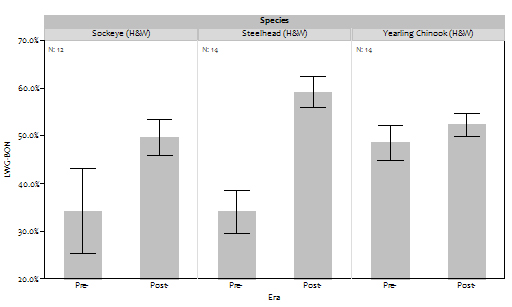September 2013: A new paper summarizes monitoring results and performance tests to date at the FCRPS dams. These studies indicate that the new configuration and operation of dams have improved juvenile fish survival through the FCRPS to levels roughly comparable to those realized decades ago, when fewer dams were in place. Annual estimates indicate an upward trend in survival of juvenile steelhead and yearling Chinook salmon migrating through the Snake and Columbia rivers over the last two decades.
q Surface passage at all eight dams: The Corps of Engineers installed the first spillway weir at Lower Granite Dam in 2001 and in early 2003 it was named the nation’s top engineering achievement of the year by the American Council of Engineering Companies. The award cited tests showing improved juvenile fish passage and described the weir as an innovative “engineering marvel” that was chosen for the ACEC’s Grand Conceptor Award over other major engineering projects such as museums and bridges. By 2009, surface passage was in place at all eight FCRPS dams on the lower Snake and Columbia Rivers.
Watch a video showing how surface passage works:
q Fewer fish go through turbines: Based on the most recent year of testing, the proportion of juvenile fish passing through non-turbine routes is now typically above 87% for spring migrants and 70% for summer migrants at all dams.
q Travel time decreased: For the period from 2005 to 2010 mean fish travel time from Lower Granite to McNary Dams was 11.2 days, compared to 21.3 days for the same reach during preceding era from 1998 to 2004. System monitoring indicates that the faster migration reflects the combined effects of flow augmentation, spill, and recently installed surface passage systems.

Survival has improved: Comparing annual estimated survival for juvenile fish going past the dams during the post-BiOp period (2008-2012) to the pre-BiOp period (beginning in 1997 through 1999, depending on the species), median survival has increased for hatchery and wild sockeye salmon (a 65.5% relative increase) and steelhead (a 57.8% increase) more than for Chinook salmon (a 0.6% increase).